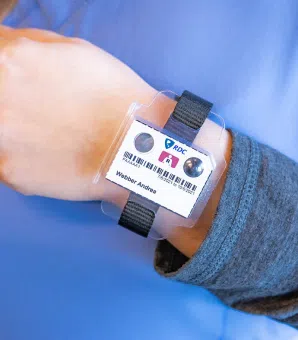
Dosimeter badge services for medical, dental, and veterinary businesses
Learn how Radiation Detection Company’s easy-to-use dosimetry solutions can boost the efficiency of your practice.
Thermoluminescent dosimeters (TLD) and Optically Stimulated Luminescent dosimeters (OSL) are the two primary types of radiation dosimeter used in passive dosimetry. In this article we will explore their use, as well as their differences in providing measurement of ionizing radiation.
We hope you find this article informative, and as always, we look forward to hearing your feedback!
Ionizing radiation is a form of energy that causes the removal of electrons from atoms and molecules of materials (including living tissue, air, and water).
Ionizing radiation is able to travel unseen and pass freely through these materials in the form of waves or particles. There are five types of ionizing radiation: alpha particles, beta particles, neutrons, gamma rays, and x-rays (electromagnetic radiation).
Passive dosimetry uses devices known as passive dosimeters, which do not need an external source of energy to operate. They are also known as integrating dosimeters, which means they only give an estimate of the cumulative dose.
Passive dosimeters record how much radiation an individual is exposed to over a specific period of time. For example, a week, month, quarter, or year.
Passive dosimeters are preferred in hospital settings and locations where occupational radiation workers are frequently exposed to low levels of radiation. These instruments are called “passive” dosimeters because they do not need to be continuously monitored.

The International Atomic Energy Agency (IAEA) ensures patients are not exposed to unnecessary and unintended radiation. While that radiation dose limits to patients are commensurate with the medical purpose (in circumstances like x-ray radiation exposure).
People in contact with radioactive substances in the course of their employment – or people who may be exposed to radiation – normally carry personal dosimeters. These dosimeters are specifically designed to record and indicate a measure of the radiation absorbed by the person.
There are 3 types of dose in radiation dosimetry: absorbed dose, effective dose, and dose equivalent. To learn more, please view our recent article, "Dosimetry 101: Everything You Need to Know About Radiation Dosimetry."
While both Thermoluminescent dosimeters (TLD) and Optically Stimulated Luminescent dosimeters (OSL) measure dose level, optically stimulated luminescence requires only light stimulation, while a TLD requires heat in order to stimulate the detector.
Both optical and thermal stimulation of the detector causes the release of electrons stored in the crystal when the radiation passes through the detector. When the electrons are released, luminescence (or visible light) is released.
To reiterate, the main difference between TLD and an OSL dosimeters is that TLD require heat, while OSL dosimeters require only optical stimulation.
As ionizing radiation passes through a thermoluminescent dosimeter, electrons in the material are moved into dosimetric traps. The electrons are held there until the detector is heated up. Once the temperature reaches a maximum of approximately 400o Celsius, the trapped electrons begin to move. This movement causes a light pulse to be emitted, also known as luminescence.
In luminescence, only a small fraction of atoms (called the emission center or luminescence center), emit light. A photomultiplier tube (PMT) is then used to count the visible light emitted. The amount of emitted light is proportional to the amount of ionizing radiation exposure that the dosimeter received.
A TLD dosimeter badge is considered to be a passive radiation detection device and has become the most commonly used solid-state radiation detector for personnel monitoring. TLD dosimeters are used by workers at nuclear power plants, in research laboratories, and medical fields - including those administering radiation therapy.
The most common types of thermoluminescent dosimeters are lithium fluoride, lithium borate, calcium sulfate, calcium fluoride, coupled with one or more impurities to produce trap states for energetic electrons.
To learn more about the TLD dosimeter and RDC's offerings, please check out our recent blog post titled, "Thermoluminescent Dosimeter [TLD] – Everything You Need to Know."

The material makeup of a TLD dosimeter and an OSL dosimeter is very similar, as both are comprised of crystalline solids. Both dosimeters capture point dose measurements, or radiation doses in a relatively small volume.
An OSL dosimeter most commonly uses Beryllium Oxide (BeO) to absorb x-ray energy. It then releases it and measures the precise dose of ionizing radiation received. Beryllium Oxide is commonly used because it is extremely durable, sensitive, and resistant to environmental influences and fading. Some OSL dosimeters use Aluminum Oxide (Al2O3:C) instead of BeO.
OSL dosimeters are generally more sensitive than TLD dosimeters, with a lower limit of detection. The lower limit of detection (LLD) is the smallest amount of an analyte (a substance whose chemical components are being identified and measured) that can reliably be detected.
To learn more about the OSL dosimeter and RDC's offering, please check out our recent blog. "5 Critical Facts About OSL Dosimeters."
Radiation Detection Company has 75 years of experience providing quality dosimetry service to over 28,000 companies throughout the US. We offer whole body, OSL whole body, ring, wrist, fetal monitoring, and area TLD solutions.
Want to learn more about our dosimetry options and how they could benefit your organization? Please visit our Solutions page to view our full suite of offerings.
Have a question that we did not touch on in this article? Please reach out to our Customer Care team, and one of our specialists will be more than happy to assist you.
Learn how Radiation Detection Company’s easy-to-use dosimetry solutions can boost the efficiency of your practice.
